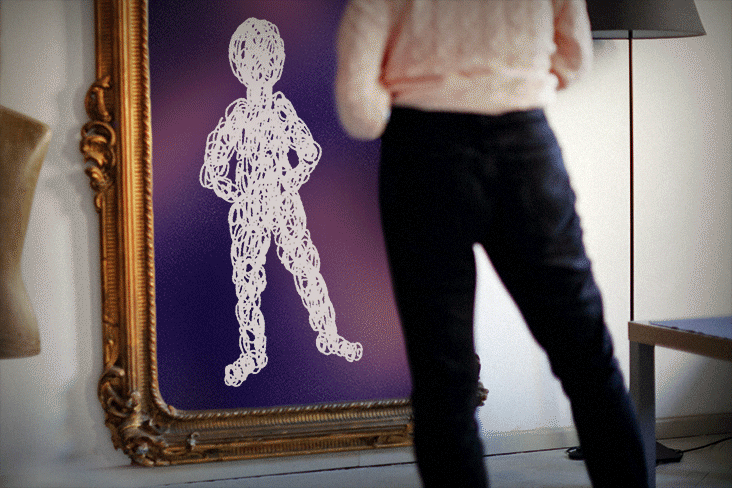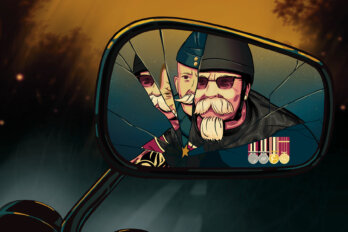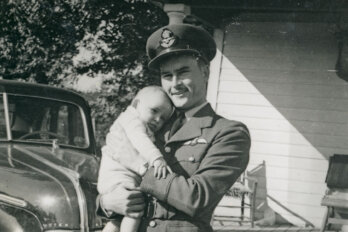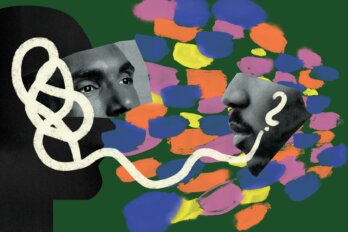The first thing to know is that the bulge is real. It is not a metaphor. The bulge is a part of my body, although it feels foreign to me.
The bulge is full of contradictions. I cannot feel the bulge, but the bulge is painful. It exceeds the reach of my nerve endings, which were sliced by plastic surgeons during what’s known as a DIEP, or deep inferior epigastric perforator flap procedure—an eight-hour surgery to reconstruct my breasts after mastectomy, using two parcels of fat and blood vessels from my abdomen.
How can I describe what the bulge looks like without taking my shirt off? Thanks to the neat work of the plastic surgeons, a tight-stitched package where a beer belly or baby bump might be squeezes my insides up and out like a corset. The resulting bulge forms a shelf above my abdomen and below my diaphragm, accentuated by a pesky diastasis recti, a cave-like separation of the abdominal muscles, wide enough to fit my fist inside. It is not the kind of situation where you can suck the tummy in; the bulge answers only to gravity. The shelf is, proportionally speaking, somewhere between the balcony at Buckingham Palace and Pride Rock in The Lion King. Too small to rest a plate on but big enough for that one colleague to ask me if I was expecting. “Expecting what?” I asked, in the manner of a woman who has had her ovaries removed.
This choice of surgery was my attempt at a silver lining around a dark cloud that has enveloped my family. A hereditary gene mutation (BRCA1) put my lifetime chance of ovarian cancer at nearly 45 percent and that of breast cancer at over 70 percent. For a decade, I was mammogrammed, MRIed, and biopsied as part of an Ontario high-risk screening program while the women on my mother’s side received diagnosis after diagnosis. Staring at the statistical cliff of age forty, I couldn’t put it off any longer.
An international 2019 study led by Toronto researchers found almost 28 percent of women with a BRCA1 or BRCA2 gene mutation opted for bilateral risk-reducing mastectomy in the hopes of avoiding breast cancer. As the name suggests, the procedure reduces the danger in high-risk groups by around 90 percent, but it doesn’t eliminate it—it’s impossible to remove all of the breast tissue, and what is left behind can become cancerous. There’s also no way to know ahead of time whether a patient will benefit from this surgery: not all women with the mutation will develop breast cancer. The idea of cutting into what was technically my healthy body felt absurd and near impossible for the first ten years after I first received my genetic test results. It wasn’t until my sister got sick that I decided to reach for something approximating peace of mind.
I was going to cheat those odds by pre-emptively removing my breast tissue, ovaries, and fallopian tubes. When it came to reconstructing my breasts, I was wary of implants and the multiple surgeries required, so opted to repurpose some of my well-earned body fat to replace the breast tissue via a flap procedure. “A free tummy tuck!” I walked around shouting happily at people I knew, most of whom nodded palely and changed the subject.
At this point, some of you might be wondering: but the bulge is not cancer. The nicest thing I can say about it is that it is like a false tumour. A dummy, like one of those papier mâché wasp nests that scare away the real thing. It is not a spot on my aunt’s spine or a lump in my sister’s armpit. Mine is a theoretical illness, a likelihood now greatly diminished. For this, I love my bulge. I say thank you. When I can’t feel thankful, I suspect it is because I am a bad person.
This is the worst part about the bulge: unlearning the ingrained thoughts and feelings I have about it. Worrying about how I look is vanity; talking about it makes people uncomfortable; feeling regret or self-pity means I’m ungrateful or insensitive to others whose situations are more dire than my own. I’m trying not to make any of those judgments. But sometimes they stick out despite my efforts.
On a regular Monday morning three years ago, the surgeon met me in pre-op with a jaunty cap and a Sharpie. I studied her hat as she marked me across my abdomen from hip to hip, around my belly button, and around my nipples, where she would cut into me an hour or so later.
The effect was that of a crudely drawn happy face across my torso. My prior optimism now felt like a weak joke. What are you smiling at? A bulge-y voice whispered in my head. That woman has a knife.
While the surgery was technically involved and necessary to reduce a significant potential threat, I periodically reminded myself that I hadn’t been diagnosed with breast cancer. Before surgery, they screened me to avoid any surprises. My luck was confirmed when my post-op pathology screens came back negative: they had scoured every bit of tissue removed and found zero cancer cells. I had evaded that particular flavour of death.
It was the aftermath that I wasn’t prepared for. I spent the 2019 holidays with two Christmas hams stuck to my chest: dense, foreign, devoid of feeling. For a year, my mental health was ravaged by a hideous grab bag of symptoms blandly referred to as “surgical menopause,” which I later discovered was code for insomnia, mood swings, and hot flashes that liquify your insides. While I now take hormones to help with that, the numbness that radiates out from my chest and navel is still with me today, as is the chronic nerve pain bordering those regions.
The bulge, I have discovered, commonly appears in the later stages of recovery. The queries in private Facebook forums are anxious. We post pictures in the comments. Some bulges are higher up or lower down; some are to one side. We ask: Is this normal? (Answer: Sort of. Flap surgeries weaken the abdominal wall and can cause hernias.) We do not ask: Who will want to see us naked now? It is not for middle-aged women to ask such questions out loud. They are reserved for the likes of the bulge, in the middle of the night, when we are meant to be sleeping.
The bulge is not where my clothes can accommodate it. If I zip it into hard pants, it aches like a bruise. It will not abide my old jeans, so I give them all away. It will not be comforted by the new jeans I buy online, so I stop buying jeans online. My new clothes are stretchy and forgiving. They hide the discomfort I feel in my own skin as I learn to stand up straight again, to find the new edges of my body moving through the world.
Every six months, I fill out a research survey. In the last two weeks, it asks, how often have you felt: Confident in a social setting? Emotionally healthy? Of equal worth to other women? Feminine in your clothes? Accepting of your body? Normal? Attractive?
“A little of the time,” I circle.
I spend some time looking at my bulge. I study it, searching for redeeming qualities. What if I stopped trying to hide it? What if every morning when I see the scar smiling across my hips in the mirror, I smiled back? I wonder if I am strong enough to do this. I turn this way and that, trying to find an angle I can live with.
When I can’t find one, I hate my bulge. It is ugly, I am ugly. I am to blame, surely. I blame myself for choosing that surgery, for my attempt to take a shortcut back to something that doesn’t exist anymore. The joke’s on you, the bulge chuckles. There are no shortcuts.
At a pandemic Thanksgiving dinner, I lean over the table and knock down a tall glass with my bulge. It breaks to pieces, and I am disproportionately upset as I clean up. I cry for my old, lost flawed body; for my new, fleshy aging body; for what, if we were in a 1960s short story, I might call my dignity.
Underneath all of those uncomfortable feelings is a simple need: to see something familiar when I look in the mirror. What I want is to recognize myself again, to see not an upright version of a butcher school diagram but a fierce size twelve in cute shoes who has veritably cheated death. Every time I start to measure the distance from here to there, I fall into that old trap that healing is linear. Reintegrating those parts of ourselves we would prefer not to look at is not a process with an ending.
The bulge’s one redeeming quality is its generosity. How can I embody this? I am giving myself permission to be soft, to stick out in weird places, to smile only when I feel like it. To accept comfort and discomfort equally and without expectation. Denying myself the space and time to mourn what I have lost—and to appreciate what I have gained—will only delay any acceptance I might someday find. There are no shortcuts.





